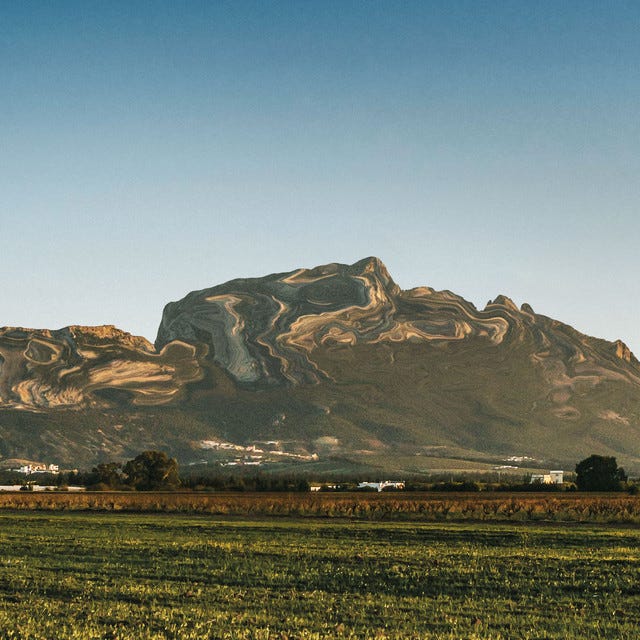Genre of the Day - Hard Drum
Album of the Day - Jbal Rrsas جبل الرصاص by Deena Abdelwahed (2023)
Has the iPhone reached its final form, its interface and software at their core barely changing over the last ten years? As social media has become fully institutionalized, have TikTok, Instagram, Twitter and Facebook established themselves as the permanent mainstays of our online networks, each with a defined niche? How much farther can music technology go without devolving simply into banal, AI-driven regurgitation? These questions of technological permanence underlie some of the questions hard drum tries to answer in regards to the world of electronic dance music. Although there’s a million little subgenres within each, house and techno as parent genres dominate the club scene, particularly in the UK along with gritty cousins drum’n’bass and jungle. Given that these genres have remained the EDM mainstays for about three decades now, there’s a question needling underneath the surface: what might lie next?
Those seeking to answer form the response in synthetic abstractions mixed with organic, percussion-forward rhythms, shattering conventions in the process. Given the variety of international dance traditions and innovations drawn upon, it’s a broad genre, vaguely covered by the term “hard drum” coined by pioneer NKC. Originating in the UK in the 2010s, it’s in part a harkening back to the sounds of UK funky a decade earlier. UK funky took offbeat rhythms by way of grime, dancehall, soca, and tribal house, lending an upbeat and buoyant sound.
Hard drum is an experimental take on the sound of UK funky. It flips it on its head, deconstructs it, and infuses rhythms with wonkiness in the form of percussion from a wide span of global influences depending on the producer’s taste and background, from Angolan kuduro and South African gqom to Brazilian batucada and Arabic dance-heavy folk dances like dabke. It’s all in the drums, as the name might suggest, as producers overlay the percussive sounds of these local scenes with unconventional electronic synthesis like squeezing five beats into a bar rather than house and techno’s typical four-on-the-floor. There’s no question that house and techno have grown far beyond the organic warehouse scene of decades ago; today, as major institutionalized genres, they function under financial structures that can favor palatability and a paying audience over inclinations towards experimentation. It’s a predicament we see play out again and again across genres. Hard drum aims to fight stagnancy by exposing listernes to homegrown sounds they’ve probably never encountered and an avant-garde approach to sonic worldbuilding. To familiarize yourself with a taste of hard drum’s style from the term’s source, here’s NKC’s 2017 Boiler Room set, before Boiler Room seemingly had the money or the care to invest in some lighting or decent camera operation.
It’s a fascinating skew, but also one at the end of a line of a traceable chain reaction: the growth of innovative dance genres in non-Western spheres that incorporate a patchwork of local and global sounds journey their way through those producers and their admirers back into those Western club scenes. Almost every work of music is an exercise in balancing old influences with new angles, but hard drum is one of the most literal and stimulating recent developments of that phenomenon. It’s one to keep note of, as today’s representative album hasn’t even touched its one year anniversary.
Deena Abdelwahed’s life tells the story of how some of hard drum’s producers might come into this unique mode of dancefloor expression. She basked in Tunis’ club scene until age 26, her musical identity formed in a hope that she could integrate the dance music she loved with the sound of the Tunisian streets in the same vein of how Black American DJs broke down musical barriers as they established these genres. For Abdelwahed, wedging unusual and potentially transgressive sounds was a way of criticizing the increasing exclusivity of EDM spaces. What results is a profoundly well-integrated web of her influences. The regality of the traditional drums punctuating “The Key to the Exit” meet the chainsaw buzz synths to epic, foreboding effect. The rhythms are unpredictable, a fluid interchange of hard electronic bass and drum punches with organic Arab drums, wobbling on “Violence for Free” and clanking back and forth on “Pre Island.” The introduction of singing in “Each Day” adds a frantic urgency perhaps belying an intention to not only move people through potent, brand-new amalgamations but to prod them to consider about what it is they’re moving to and why.




